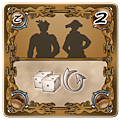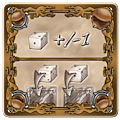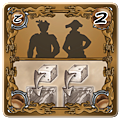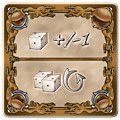PDF - Links
Deutsche Regeln für Shanghaien
English Rules for Shanghaien
Italiano
Francais
Game Idea
The infamous dockside bars of Shanghai can get pretty
rough. More than one sailor wandered in for nothing
more than a quick drink only to wake up, head pounding,
in the cabin of a tramp steamer. And so this recruitment
method, favoured by unscrupulous Captains, came to be
known as being “Shanghaied”!
The notorious Captains Ramon “El Dado” and Terrible
Michael are fighting over who will put together the best
crew. They have agreed to roll dice for them – while
thinking nothing of using dirty tricks to get ahead!
|
Players try to claim the stronger crews in their respective nationalities.
They take turns assigning dice to the sailors. As soon as one
player passes, the cards are distributed, with each player receiving
the cards in which they have the dice majority. “Dirty Tricks” cards
let the players improve their dice results or increase the size of their
crew. During scoring at the end of the game, the player with the
stronger crew in each nationality receives victory points equal to the
strength of the weaker crew.
|
Game Components
- 48 Tavern cards, including:
- 40 Sailor cards (5 cards in each of 8 colours with values 1, 2, 3, 3, 4)
- 8 “Dirty Tricks” cards
- 12 dice (6 in each player colour)
- 2 Captain figures (1 in each player colour)
- 1 set of rules
Game Setup
- Give each player the Captain and 6 dice in his colour.
- Shuffle the Tavern cards and place them on the
table as a face-down draw pile.
- Reveal 6 cards from the draw pile and place them
in a row on the table. This row is called the Tavern.
- The most rough-and-ready player starts.
Game Play
The game is played over eight rounds. Each round
ends with the cards being distributed – the sailors are
Shanghaied. Players take turns during the round. On your
turn, you must carry out one of the following actions:
A. Roll and add dice or
B. Shanghai, thereby ending the round.
It is then the other player’s turn.
A. Roll
As long as you still have at least 2 dice in your supply,
you can choose the “Roll” action.
Roll 2 dice from your supply, choose 1 die and place it
onto the corresponding Tavern card. There are always
6 cards laid out in the Tavern. Each card therefore has a
die value assigned to it. 1 is assigned to the first card in
the row, 2 to the second card, etc. The starting player in
each round decides which end of the row will be assigned
the 1 for the round.
Add the chosen die to your side of the corresponding card.
Place the second die back into your supply.
B. Shanghai
Use this action to end the current round and distribute
the cards. You can only choose this action once you have
added at least 2 dice to cards. If you only have 1 die left
in your supply, then you must choose to “Shanghai”:
Distribute the cards according to the following rules:
- If there are no dice added to a card, then that card is removed from the game.
- If there are only one player’s dice added to a card, then that player receives the card.
- If there are dice from both players added to a card, then the player who added more dice to that card receives it.
- If both players added the same number of dice to a card, then the player with the higher sum on the dice added to the two neighbouring cards receives the card.
If there is still a tie, then the card is removed from the game.
Note: The cards at each end of the row have only one neighbouring card.

Example: Anna starts the round and rolls a 2 and a 4. She decides to add the 2 to the card lying second from the end on her left. In doing so, she sets
the die values assigned to each card for this round. Bernd rolls a 1 and a 5. He decides on the 5 and adds it to the fifth card from the Anna’s left.
Important: The player who chose the “Shanghai” action
should also distribute the cards so that it is clear who ended the round.
When you receive Sailor cards, place them face-up in front of you, sorted according to colour. Make sure that each
card’s value is always clearly visible.
Each colour represents a nationality: Red – American, Light Blue – French, Dark Blue – German, Yellow – Chinese,
Orange – Dutch, Purple – Turkish, Green – Spanish, Grey – Italian.
When you receive a “Dirty Tricks” card,
place it face-up on its own, away from your other cards.
End of a Round
Once all 6 cards have been distributed, the round is over. Return all dice to both players. The player who chose to
Shanghai draws 6 new cards and lays them out on the table, forming a new Tavern. The other player now gets to
start the next round.

Example: Anna added 2, 2, 3, 6, 6, while Bernd added 3, 4, 5, 6, 6. The first card is removed from the game. Anna gets the second card, since she
was the only player to add dice to it. Both players added a single die to the third card. Anna’s neighbouring dice add up to 4 (2 x 2), as do Bernd’s (1
x 4). Since this is a tie, the card is removed from the game. Bernd gets the fourth and fifth cards (only he added dice to them). Both players added 2
dice to the sixth card, but since Bernd’s neighbouring dice add up to 5 and Anna’s to 0, Bernd gets the sixth card as well.
Dirty Tricks
You may only play 1 “Dirty Tricks” card each round. As a reminder that you have already played your card this round,
place your Captain figure next to the first card in the Tavern. At the end of the round, you may take your Captain back.
You may only play a “Dirty Tricks” card immediately after having rolled the dice. This means that any “Dirty
Tricks” cards you receive in the last round of the game cannot be used.
When you play a “Dirty Tricks” card, you must choose one of the two actions on the card:
2 Sailors


Add the card to the Sailors you already have in a nationality of your choice. The card acts like a wild card, and counts as a
2-value Sailor card of that nation.
Important: This card must always be together with at least one Sailor card so that the card’s nationality is
determined. It may never be used on its own to act as a missing nationality.
Note: If you use the wild card action for this card, place it, half covered, beneath one of your Sailor cards in the appropriate nationality. It becomes
a Sailor card and stays that way until the end of the game. You are not allowed to use the card’s other action any more.
Die +/-1


You may adjust the result of one of the two dice just rolled by plus or minus
one. The “Dirty Tricks” card is then removed from the game.
Note: The die result cannot be adjusted to higher than 6 or lower than 1.
Add Both Dice


You may add both of the dice just rolled to their respective cards. The
“Dirty Tricks” card is then removed from the game.
Roll Again


You may roll both dice again. You must then choose one of the two dice
and add it then to a card in the Tavern. The new result is
fixed; you can’t change your mind and use the first result
instead. The “Dirty Tricks” card is then removed from the
game.
Game End
The game is over after the eighth round. At that point,
the Tavern is empty and the draw pile exhausted. Scoring
follows.
Scoring
Players compare the strengths of their Sailors in each nationality:
- If both players have Sailors in a nationality, then the
player with the stronger Sailors removes his Sailors
from the game and receives his opponent’s Sailors from that nation.
In the case of a tie all Sailors from that nation are discarded.
- If only one player has Sailors from a nation,
then he keeps his cards.
Each player adds up his Sailors’ values as Victory Points.
For each “Dirty Tricks” card not used, players score
1 additional point.
The player with the most Victory Points wins.
|
colour
|
Anna
|
Bernd
|
|
|
3, wild card (2),
wild card (2)
|
-
|
|
|
1, 4
|
2, 3
|
|
|
1, 2, 3
|
3, 4
|
|
|
1
|
3, 3, 4
|
|
|
-
|
wild card
add both dice
|
Example: Since Bernd has no Spaniards (Green), Anna gets to keep hers.
Both French crews (Light Blue) are worth the same and are removed from
the game. Bernd has the stronger American (Red) crew as well as the
stronger Chinese (Yellow) crew. Bernd’s American and Chinese Sailors are
removed from the game and he receives Anna’s cards instead.
Anna has 7 points (Spaniards). Bernd wins the game with 8 points:
6 (Americans) + 1 (Chinese) + 1 (Dirty Tricks).
The authors and publisher thank the many playtesters for
their patience and comments.
Authors: Roman Pelek and Michael Schacht – www.michaelschacht.net
Illustration & Layout: Christian Fiore
Das Format Werbeagentur | www.das-format.de
Translation: Patrick Korner
©2008 ABACUSSPIELE Verlags GmbH & Co. KG, Dreieich
All Rights Reserved. Made in Germany.
www.abacusspiele.de
Remarks to the Online Version on Yucata.de
Optional Game Variant
Michael Schacht (one of the game authors) had a wish, which we implemented. You can choose in the invitation whether both players get an additional wild card at the start of the game.
This is the additional trick card:

Colours
Both players look at the game from the same point of view.
"My" dice are always placed under the cards and the dice of the opponent above the cards.
"My own colour" is always Red and the opponent is always shown as Blue.
Round Start
The start player must choose the direction for the dice in this round.
He can see the cards on the table and the rolled dice - by clicking on one of the two grey captains (left or right)
the player fixes the place for the die number 1. The grey captains are placed there.
They are place holder for the real coloured captains, which are placed there later, after using a dirty trick.
Round End
At the end of each round (triggered by "shanghai") numbers and arrows show
which player got how many points at the cards and which player gets which cards.
Cards without arrows are removed from the game.
This overview is also visible for the next player at the start of the next round.
By rolling the dice, the next round starts.
Dirty Tricks
If you can use dirty trick cards, they will be shown besides the rolled dice.
You can decide not to use a dirty trick by clicking directly on a die. Otherwise you can click on the upper or lower half of a trick card to use this dirty trick.
Afterwards the coloured captains go to the cards to show: you used a trick and cannot use a second in this round.
Score Table
At the bottom of the game window you can see a table with the most important scores,
so you can come back to a game and get an overview without counting cards and points.
Both of you can see the points of both players at the given time. Red numbers are your own scores and blue are for the opponent.
Black numbers show how many cards and points are still available for each color (on the table and in the card stack).
After "shanghai" the table will calculated anew.
Overviews
To get a clean compact view on the game, all the received cards are shown in separate windows. So you don't need to calculate too much.
You can see these windows by hovering above the numbers on the table - you can also click on them if you use a touch device.
One more window comes up by hovering over the game score - just left of the player names.
It shows which game points you get by comparing the card points and what goes directly to the overall score.